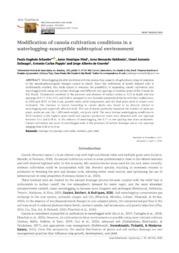Modification of canola cultivation conditions in a waterlogging-susceptible subtropical environment.
Modification of canola cultivation conditions in a waterlogging-susceptible subtropical environment.
Author(s): SCHAEFER, P. E.; NIED, A. H.; HELDWEIN, A. B.; DALMAGO, G. A.; PAPPIS, A. C.; GOUVEA, J. A. de
Summary: Abstract: Waterlogging directly interferes with the production capacity of agricultural crops in response to the morphophysiological changes caused to plants. Since the cultivation of poorly drained soils is traditionally avoided, this study aimed to evaluate the possibility of expanding canola cultivation into waterlogged soils using soil surface drainage and different row spacings in lowland areas of Rio Grande do Sul, Brazil. Treatments consisted of the presence and absence of surface drains at 0.25 m depth and row spacings of 0.17, 0.34, 0.51, and 0.68 m arranged in two-factorial randomized blocks with four replications, in 2018 and 2019. In this study, growth traits, yield components, and the final grain yield of canola were evaluated. The increase in lateral branching in canola plants was found to be directly related to waterlogging and negatively affected yield. The use of drains positively impacted the number of pods per plant, seeds per pod, the 1,000 seeds weight, and grain yield. The more intense waterlogging conditions in 2018 resulted in the highest grain yield and superior production traits were obtained with row spacings between 0.41 and 0.48 m. In the absence of waterlogging, the 0.17 m row spacing was more productive. Canola cultivation can occur in waterlogged soils in the presence of surface drainage and at row spacings ranging from 0.40 to 0.50 m.
Publication year: 2023
Types of publication: Journal article
Unit: Embrapa Wheat
Observation
Some of Embrapa's publications are published as ePub files. To read them, use or download one of the following free software options to your computer or mobile device. Android: Google Play Books; IOS: iBooks; Windows and Linux: Calibre.
Access other publications
Access the Agricultural Research Database (BDPA) to consult Embrapa's full library collection and records.
Visit Embrapa Bookstore to purchase books and other publications sold by Embrapa.

